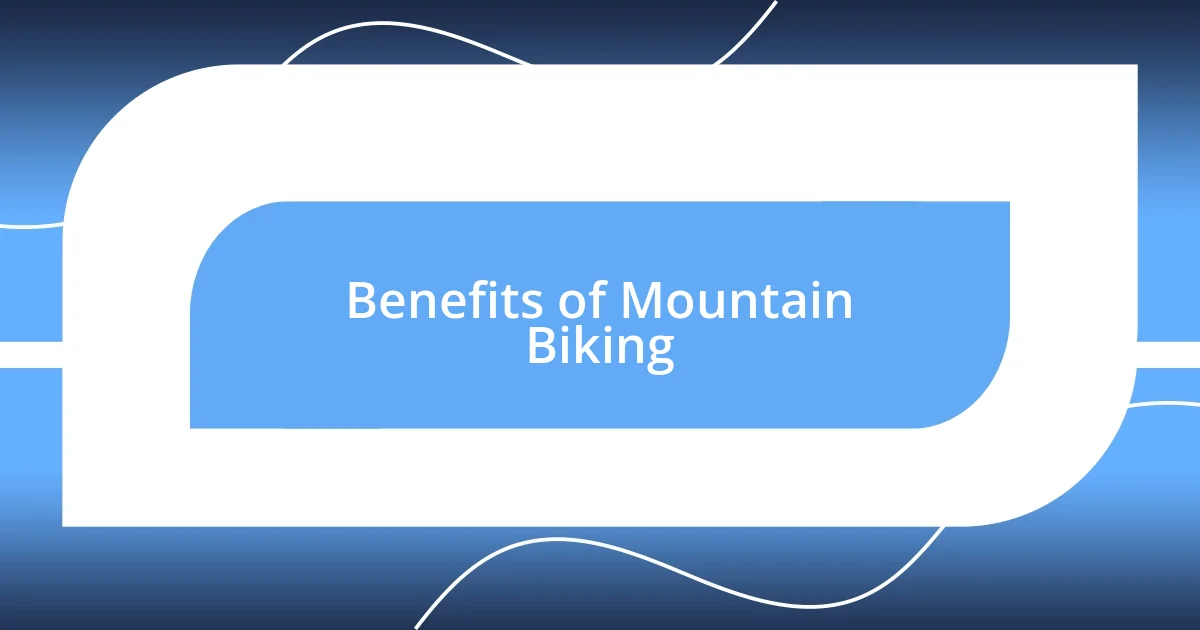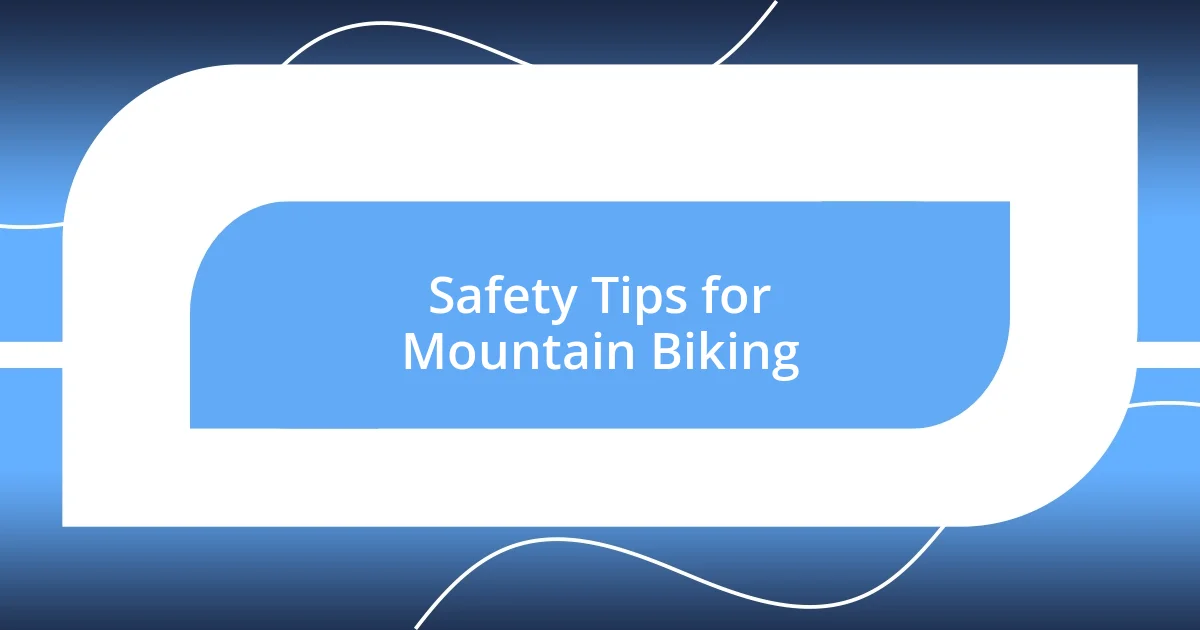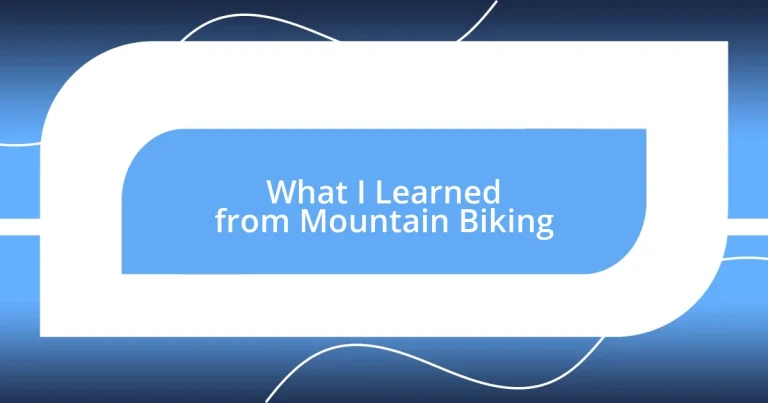Key takeaways:
- Mountain biking enhances physical fitness and mental resilience, promoting a deep connection with nature and encouraging social interactions through community building.
- Essential skills for beginners include effective braking, balancing techniques, and understanding gear shifting to navigate terrains confidently and safely.
- Prioritizing safety through proper equipment, gear checks, and riding within one’s skill level is crucial for an enjoyable and secure mountain biking experience.

What is Mountain Biking
Mountain biking is a thrilling outdoor activity that combines cycling with the adventure of rugged terrains. I remember the first time I hit a rocky trail; my heart raced with both excitement and fear. The balance between navigating obstacles and enjoying the breathtaking scenery made me realize how alive I felt in that moment.
This sport is not only about speed but also about strategy. Each turn of the pedals challenges your skills, demanding focus and adaptability. Have you ever found yourself skidding to a stop at the edge of a steep drop? That gut-churning moment teaches you the importance of control and the thrill of pushing your limits.
At its core, mountain biking is a celebration of nature and personal growth. Riding through the trees, feeling the breeze against my skin, I often reflect on how every ride offers the chance to connect with the environment in a profound way. What can be more rewarding than conquering a challenging ascent and soaking in the view that rewards your effort?

Benefits of Mountain Biking
Mountain biking offers a multitude of benefits that go beyond just physical fitness. I remember feeling my legs burn and my heart pump on challenging climbs, but each ride not only strengthened my muscles—it boosted my mental resilience. Confronting the wild elements and tackling steep descents filled me with a rush of adrenaline and a deep sense of accomplishment. These experiences foster a valuable connection between my mind and body that I cherish.
Here’s a snapshot of the benefits I discovered:
- Physical Fitness: Improves cardiovascular health, builds strength, and enhances endurance.
- Mental Clarity: Reduces stress and promotes mental well-being by allowing time to disconnect and recharge.
- Connection with Nature: Encourages appreciation for the outdoors, fostering a sense of peace and mindfulness.
- Community Building: Engages with fellow riders, creating friendships and a supportive network.
- Skill Development: Enhances coordination, balance, and problem-solving skills through navigating diverse terrains.
Every ride I undertake not only challenges my body but also elevates my spirits in ways I never expected. It’s these moments of awe—as I crest a hill and gaze at a stunning vista—that truly remind me why I cherish this sport.

Essential Skills for Beginners
When you’re just starting out in mountain biking, mastering essential skills is crucial for both safety and enjoyment. I recall my early days when simple maneuvers like braking seemed intimidating. Knowing how to brake effectively—using both front and rear brakes—made a world of difference. It not only helped me maintain control on steep descents but also gave me the confidence to tackle new trails.
Balance is another core skill that beginners should focus on. I remember juggling my weight while trying to navigate tight corners; the realization that shifting my body posture could drastically shape my bike’s trajectory was enlightening. Practicing in a safe area helped me develop this skill, allowing me to ride more confidently over rough terrain.
Understanding gear shifting is equally important. I used to feel lost in the technical aspects of my bike, but learning when to shift gears helped me tackle climbs with ease. With every successful ascent, I felt a surge of pride, knowing I had come a long way from those early rides where I struggled to keep up.
| Skill | Description |
|---|---|
| Braking | Use both brakes effectively to maintain control and prevent skidding. |
| Balancing | Shift your weight to navigate tight corners and rough terrains with ease. |
| Gear Shifting | Understand when to shift gears to ease climbs and maintain momentum. |

Overcoming Challenges in Mountain Biking
I remember a grueling uphill stretch that felt insurmountable, leaving me questioning my abilities. But instead of giving in to frustration, I decided to break it down into manageable segments. With each short climb I conquered, I could feel my confidence swell—proof that persistence can turn daunting challenges into satisfying victories.
One particularly rainy day, I found myself slipping on mud-covered trails, grappling with the bike as it fought against gravity. It drove home the lesson that adaptability is key; my riding style had to shift with the conditions. I learned to approach obstacles with patience and a sense of play, figuring out how to use momentum and weight distribution to my advantage. What if I hadn’t embraced those changes? I might still be stuck in my comfort zone.
The thrill of mastering tricky descents is something I’ll never forget. I distinctly remember the first time I managed to navigate a steep drop without panic setting in. That ride taught me the importance of focus and trust—trust in my bike, but more importantly, trust in myself. Isn’t it remarkable how facing our fears head-on can lead to profound growth? Overcoming these challenges has truly transformed my approach to not just mountain biking, but to life itself.

Choosing the Right Equipment
When I first got into mountain biking, choosing the right equipment felt overwhelming. I remember staring at a wall of bikes at the shop, feeling like I was picking a partner for an adventure. It became clear to me that the right fit is essential—not just in terms of size, but also for the riding style and the terrain I wanted to conquer. Each bike has its personality, and finding one that aligned with mine was a revelation.
I quickly realized that investing in a quality helmet was non-negotiable. The sense of security it brought added a layer of freedom while riding. I once took a tumble on a rocky path (let me tell you, it was a wake-up call)—but my helmet did its job. I often think, how do riders feel when they opt for something less protective? That moment taught me the importance of prioritizing safety over style, and it felt good to know I was making a wise choice for my well-being.
Don’t overlook the importance of the right accessories either! I learned early on that comfortable gloves and proper footwear can make a world of difference. The first time I went on a long ride without gloves, my palms were raw by the end, and I couldn’t help but wonder why I hadn’t considered this sooner. When you’re out there, navigating through nature, every detail matters—what if the little things could turn a tough ride into a fantastic experience? That’s the magic of choosing the right equipment; it sets the tone for your entire journey.

Safety Tips for Mountain Biking
When it comes to mountain biking, safety should always be at the forefront of your mind. I remember my first ride on a rocky trail; I felt invincible until I hit a loose stone and went tumbling. That experience taught me the significance of checking my bike for loose parts before a ride. A quick inspection can save you from a painful spill and keep your adventures as enjoyable as they should be.
Wearing the right protective gear is non-negotiable. I often chuckle when I see riders going without knee or elbow pads, recalling a moment when my knee took a hit during an unexpected fall. Those pads aren’t just for show; they’re a crucial line of defense against scrapes and bruises. Have you ever felt that rush of relief after a fall, knowing you’re protected? It’s like being wrapped in a safety blanket while pushing the limits of what you can do.
Another tip I’ve learned is to ride within your skill level, especially on unfamiliar trails. I once tried to follow my more experienced friends down a steep descent, and it ended up being a nerve-wracking experience. It taught me that it’s vital to recognize my own limits and choose paths that match my confidence and ability. After all, is there really any shame in taking it slow? Embracing your own pace can lead to greater enjoyment and less risk of injury—a lesson I wish I’d learned sooner!












